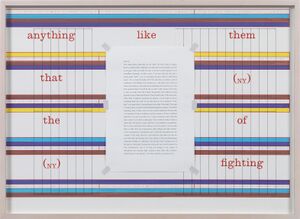Letters to the Red Crayola VII, 1973-2012
| Letters to the Red Crayola VII, 1973-2012 | |
|---|---|
 | |
| Art & Language | |
| Project | |
| Year | 2012 |
| Dimensions | 51.8 × 71 cm[1] |
| Materials | Ink, acrylic, collage and mixed media on paper |
Text
Dear M. This comes from a place that we call 'dark'. We don't mean to suggest that it's (wholly) bad or shameful, but rather that it is inscrutable, not only to the gaze of the art world, but also to all but a small fragment of our immediate community. In other words. it's private. But why call such a private place 'dark'? Are we describing the place itself in some literal sense? Do we keep the lights off? (The idea that we produce work in conditions of bad lighting is an enticing one — and partly true.) Or do we deduce the darkness of the place from something else, from the very work that's produced here? It could be that we call it 'dark' because, from time to time, we make work that is black, the transfer of the adjective being therefore a sort of rhetorical flourish. That would be sad. At the same time, while 'dark' is indeed a synonym for 'private', we do mean to convey something about the work. To say that what we do is produced 'in the dark' is to imply that it is not produced in the light. What light? The light of certain forms of critical and institutional attention, perhaps. It would be surprising, then, if there were not some mutual implication between the work produced in these conditions and the existence of these conditions themselves. So can we say that it is in virtue of what the work is that this letter comes to you from a dark place? That would be better to than to reduce the work itself to a mere reflection of its conditions of production. But we don't quite know how militant to be about that as we are quite likely to offer some sort of description, albeit oblique and rather indirect, of the circumstances of production and to build that description into the 'content' of the work. However, such reflexivity had better not take the cute form that has become one of the clichés of the post-Duchampian settlement. Perhaps it's sufficient to say that the work is produced out of the light in a dark place, because that is the only way it can be made to be both self-destructive and to do long term damage to the culture of institutional and corporate light. Inspector Denis didn't like Courbet's studio because it was 'gloomy'. Now that would be a synonym too far.
Interpretations
- The text references Index: The Studio at 3 Wesley Place (1982)
- Inspector Denis is a character in Victorine (1984)